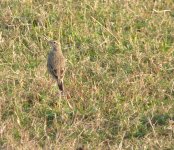Dear experts!
I could only get one back shot of this Pipit - could not get a frontal view - is there any chance of ID..? I figure it's a Paddyfield Pipit but not sure!
Photo was shot in Kabini Backwaters (12.039171607192017, 76.42913703063083) - beginning of Summer here!
Many Thanks and Best Regards,
Sandeep
I could only get one back shot of this Pipit - could not get a frontal view - is there any chance of ID..? I figure it's a Paddyfield Pipit but not sure!
Photo was shot in Kabini Backwaters (12.039171607192017, 76.42913703063083) - beginning of Summer here!
Many Thanks and Best Regards,
Sandeep





